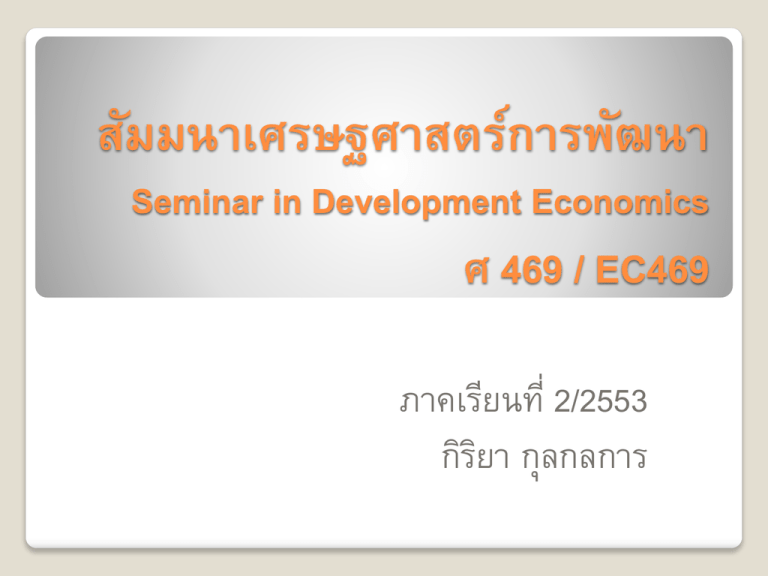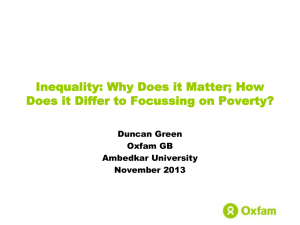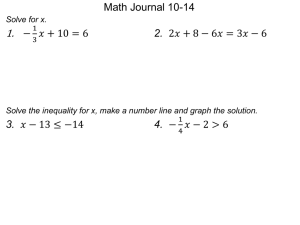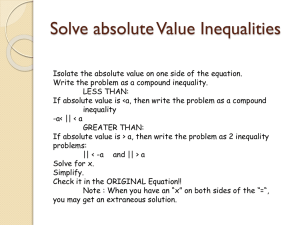
สัมมนาเศรษฐศาสตร์การพัฒนา
Seminar in Development Economics
ศ 469 / EC469
ภาคเรียนที่ 2/2553
กิรยิ า กุลกลการ
กำหนดกำรบรรยำย
ครั้งที่ 1 (8 พฤศจิกายน)
◦ การเรียน การสอน และการวัดผล
◦ ความเหลื่อมล้าทางเศรษฐกิจและทางออกประเทศไทย
แนวคิดทางทฤษฎี
สถานการณ์ความเหลื่อมล้าทางเศรษฐกิจในประเทศไทย
ครั้งที่ 2 (15 พฤศจิกายน)
◦ วิธีการทาวิจยั การเขียนงานวิจยั และการนาเสนองานวิจยั
ครั้งที่ 3 (22 พฤศจิกายน)
◦ อบรมวิธีการสืบค้นเอกสาร และการอ้างอิง โดย บรรณารักษ์
“ความเหลื่อมลา้ ทางเศรษฐกิจ
กับทางออกประเทศไทย”
Income Inequality
How to measure inequality?
Why should we care?
What can we do about it?
4 criteria for inequality measurement
Anonymity Principle
◦ It doesn’t matter who earns the income.
Population Principle
◦ Cloning the entire population should not alter
inequality.
Relative Income Principle
◦ Scaling everyone’s income up or down by the same
percent shouldn’t change inequality.
Dalton’s Transfer Principle
◦ A transfer of income from a poorer person i to a
richer person j must increase inequality.
Lorenz Curve
Lorenz Criterion – if a Lorenz curve lies
at every point to the right of another Lorenz
curve, then that distribution is more unequal.
Inequality Measures
Ranges = (yh-yl)/ybar
Kuznets Ratio = ratio of share of income
earned by the richest x% to the share of
the poorest y%
MAD – Mean absolute deviation
These 3 measures don’t satisfy Dalton.
Gini coefficient
◦ Graphically, it is the area between the Lorenz
curve and the 45 degree line divided by the
area below the 45-degree line.
1
MAD
N
N
y
i 1
i
Person (j)
yj
yj
1
1
4
2
2
3
3
8
3
4
9
4
N=4
5
MAD=14/20
MAD increase from 14/20 to
16/20 if guy 2 gives $1 to guy 4.
Person (j)
yj
1
1
4
2
1
4
3
8
3
4
10
5
N=4
5
MAD=16/20
yj
MAD stays 14/20 if guy 1 gives $1
to guy 2.
Person (j)
yj
yj
1
0
5
2
3
2
3
8
3
4
9
4
N=4
5
MAD=14/20
MAD will work for Dalton if we transfer money
from below mean to above mean.
Gini:
Person (j)
N N
1
y j yk
2
2 N i 1 k 1
yj
N
y
k 1
j
yk
1
1
0+1+7+8=16
2
2
1+0+6+7=14
3
8
7+6+0+1=14
4
9
8+7+1+0=16
N=4
5
60/(2*16*5)
=60/160
Gini: increase from 60/160 to
68/160 if guy 2 give $1 to guy 4
N
Person (j)
yj
1
1
0+0+7+9=16
2
1
0+0+7+9=16
3
8
7+7+0+2=16
4
10
9+9+2+0=20
N=4
5
68/(2*16*5)
=68/160
y
k 1
j
yk
Gini: increase from 60/160 to
64/160 if guy 1 give $1 to guy 2
N
Person (j)
yj
1
0
0+3+8+9=20
2
3
3+0+5+6=14
3
8
8+5+0+1=14
4
9
9+6+1+0=16
N=4
5
64/(2*16*5)
=64/160
y
k 1
j
yk
Inequality vs Inequity
Is inequality of outcomes the right thing
to measure?
◦ If one person studies hard and get an A and
the other parties and gets a C, is that bad?
◦ Why would you ever work hard if everyone
always ended up with the same amount of
money?
Inequality in opportunities is much more
socially unjust.
Study done in Ecuador looking at
cognitive development of Ecuadorean
children ages 3-6 using vocabulary
recognition test.
Youngest children perform broadly the
same regardless of wealth or maternal
education.
Poor kids do way worse by age 6. Huge
disadvantage at an early age.
Study done in Brazil decomposing total
inequality into a component based on
observed opportunities and a residual.
Define opportunities as the
circumstances lying beyond an
individual’s control.
How do you measure it?
Regress log of wages on a constant,
race, parental schooling, father’s
occupation, region of birth, plus years
of own schooling and whether or not
they migrated.
The first ones represent opportunity
while the last two represent effort.
Look at people in 1996 in different age
groups. The bars are total inequality
with inequity on the top.
For the older cohorts inequity is around
41% of total inequality.
For the younger cohorts inequity is
around 36%.
Slight decrease over time.
Probably an underestimate since it
doesn’t control for lots of things like
sex, school quality, family health, etc.
Why should we care?
Fairness – utility functions value a unit
increase in the income of a poor person
more than the same increment going to a
richer person
◦ Experimental evidence: Ultimatum Game
◦ Survey in 69 countries
Relative income is important for ideas about
fairness.
Saving
S=>I=>Growth
Draw a graph with savings on the y-axis and
income on the x-axis.
If it is convex, inequality is good for growth.
If it is concave, inequality is bad for growth.
What about if it looks more like an S?
For poor countries, inequality is good for
growth.
For rich countries, inequality is bad for
growth.
Internal bounds
Underinvestment in small industries
Underinvestment in agriculture
Underinvestment in agriculture
Political redistribution
Inequality => median voter will be poor
and will vote for a high progressive tax
=>the rich won’t have an incentive to
work hard => retard growth
Inequality => social tensions => political
instability => discourage investment
Inequality => the elite may have leeway
to choose strategies benefitting
themselves rather than the whole
population
What can we do?
Early child development programs
Basic education and health initiatives
Land access policies
Equitable justice systems
Unemployment, health and crop insurance
Microfinance
Tax reform
Social welfare
Distribution of Living Standards in
the Contemporary World
Variation in Infant Mortality
Income Inequality Within and Between
Countries
◦ Income is very unequally distributed across the
world. In 2000, the richest 20% of 6.1 billion
world population have 74% of the income. The
poorest 20% have only 2% of the income.
Poverty and Income Inequality
in Thailand
Thailand has grown economically at the
satisfactory annual rate of 7%, its
achievements in terms of income
inequality have been less successful.
การพัฒนาของเศรษฐกิจไทยนับตัง้ แต่ชว่ งปี 2530 เป็ นต้นมา ส่งผลให้
ความยากจนลดลงอย่างมาก จากกว่า 22 ล้านคนในปี 2531 หรือคิดเป็ น
42.3% ของประชากรทัง้ ประเทศ ลดลงเหลือเพียง 8.5 ล้านคน หรือคิด
เป็ น 5.4% ของประชากรทัง้ ประเทศในปี 2550
From UNDP’s 2006 report, Thailand was
ranked 74th in income distribution from a
total of 177 countries and a Gini Index of
42.
Poverty in Thailand
Poverty line from NESDB
◦ 1994 838 baht/month
◦ 2004 1242 baht/month
◦ 2007 1443 baht/month
(Bangkok 2065 Baht/month)
The poor 5.4 million (8.5%) by HCR
The poorest region
◦ N/E of Thailand (2.8 million, 52.2%)
◦ Highest density of poor people - Mae Hong Son
(67%)
Poverty in Thailand
Poverty Index 1988 1990 1992 1994 1996 1998 2000 2002 2004 2006 2007
Poverty Line
(Baht/person/
month)
633
692
No. of poor
people
(millions)
22.1
18.4 15.8 10.7 8.5
HCR (%)
42.21 33.69 28.43 18.98 14.75 17.46 20.98 14.93 11.16 9.55
8.48
Poverty Gap
Ratio
11.40 8.05 6.62 3.92 2.85 3.35
SPG or Severity
of poverty
4.30
790
838
953
1,130 1,135 1,190 1,242 1,386 1,443
10.2
2.82 2.23 1.22 0.85 0.99
12.6
9.1
7.0
6.1
5.4
4.24
2.75
2.01
1.81
1.45
1.30
0.81
0.56
0.53
0.41
ั
ทีม
่ า : ข้อมูลจากการสารวจภาวะเศรษฐกิจและสงคมของคร
ัวเรือน สาน ักงานสถิตแ
ิ ห่งชาติ
ประมวลผลโดย สาน ักพ ัฒนาเศรษฐกิจชุมชนและการกระจายรายได้ สศช.
กำรกระจำยรำยได้ของประชำชนไทย
ญี่ปุ่นและประเทศกลุ่มสแกนดิเนเวีย: 3-4 เท่ำ, ประเทศอื่นๆ ในทวีปยุโรปและอเมริกำเหนือ: 5-8 เท่ำ
ประเทศในภูมิภำคเอเชียตะวันออกเฉียงใต้: 9-11 เท่ำ
Thailand's Gini Coefficient
0.540
0.536
0.530
0.522
0.520
0.520
0.515
0.513
0.511
0.510
0.507
0.507
0.500
0.497
0.493
0.490
0.487
0.480
0.470
0.460
1997
1998
1999
2000
2001
2002
2003
2004
2005
2006
2007
ประเทศที่ประสบความสาเร็จในการกระจายรายได้ มีค่า Gini Coefficient อยู่ที่ประมาณ 0.25-0.3 เท่านัน้
การกระจายรายได้ของประชาชนไทย เมื่อวัดจาก Gini coefficient
(ปี 1960-2005)
ที่มา: รายงานการพัฒนาคนของประเทศไทยปี 2552 ของ UNDP อ้างจากข้อมูลของ Hal Hill
Thailand’s income inequality
ระหว่างกลุ่ม กลุ่มผูม
้ รี ายได้ต่าสุด
20% มีรายได้รวมกันแค่ 4-5%
ในขณะที่ กลุ่มคนทีม่ รี ายได้สงู สุดของประเทศ 20% มีรายได้รวมกันอยู่
ประมาณ 55% เกินกว่าครึง่ หนึ่งของรายได้ทงั ้ ประเทศ
ระหว่างจังหวัด ในปี 50 ครัวเรือนทีอ่ ยูใ่ นกรุงเทพมีรายได้ 39,000
บาท/ปี บางจังหวัด เช่น นครพนม ศรีษะเกษ มีรายได้ประมาณ 10,00011,000 บาท/เดือน ขณะทีแ่ ม่ฮอ่ งสอนจนสุดของไทยมีรายได้ 7,250
บาท/เดือน
ระหว่างเวลา ในช่วง 20 ปี ทผ
่ี า่ นมา ผลของความเจริญทีเ่ กิดขึน้ กระจุก
อยูใ่ นมือของคนรวยเท่านัน้ โดยกลุ่มคนทีจ่ นสุด 20% มีรายได้ต่อคนเพิม่
จาก 244 เป็ น 1,228 บาท/เดือน หรือเพิม่ 980 บาท/เดือน ในขณะที่
กลุ่มคนทีร่ วยสุด 20% มีรายได้เพิม่ จาก 2,897 เป็ น 15,248 บาท/เดือน
หรือเพิม่ 12,351 บาท/เดือน มากกว่าเกือบ 12 เท่า
สำเหตุของควำมเหลื่อมล้ำและทำงออก…
Outline งำนวิจยั
สภำพปั ญหำ
แนวคิดทำงทฤษฎี
วิเครำะห์นโยบำยที่ประเทศไทยใช้
นโยบำยที่ใช้ในต่ำงประเทศ
ข้อเสนอแนะเชิงนโยบำย









